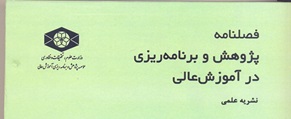مشتری مداری و کاربرد آن در نظام آموزش عالی : مورد آموزش عالی کشاورزی در استان خوزستان
نویسندگان
1 کارشناس ارشد ترویج و آموزش کشاورزی دانشکده مهندسی زراعی و عمران روستایی دانشگاه کشاورزی و منابع طبیعی رامین
2 استادیار بخش ترویج و آموزش کشاورزی، دانشکده کشاورزی دانشگاه شیراز
3 استادیار بخش ترویج و آموزش کشاورزی، دانشگاه کشاورزی و منابع طبیعی رامین
چکیده
در این مقاله مشتری مداری به عنوان یکی از اصول اساسی مدیریت کیفیت فراگیر در دانشگاه کشاورزی و منابع طبیعی رامین و دانشکده کشاورزی دانشگاه شهید چمران اهواز بررسی شده است. مطالعه به روش توصیفی پیمایشی انجام شده و اطلاعات با استفاده از ابزار پرسشنامه و از 322 نفر از دانشجویان و 81 نفر از اعضای هیئت علمی دو دانشگاه به دست آمده است. از روش نمونهگیری تصادفی طبقهای برای انتخاب دانشجویان دوره کارشناسی استفاده شد و از دانشجویان دوره های تحصیلات تکمیلی و اعضای هیئت علمی سرشماری به عمل آمد. یافتههای پژوهش نشان داد که وضعیت مشتری مداری در دو دانشگاه مورد مطالعه مطلوب نیست. همچنین، تفاوت معنیداری بین دیدگاه دانشجویان و اعضای هیئت علمی دو دانشگاه درخصوص میزان مشتریمداری وجود دارد. بر مبنای یافتهها بالاترین و پایینترین میزان مشتریمداری به ترتیب در ساختارهای محسوسات و انتقال به دست آمد. گروههای آموزشی زراعت و اصلاح نباتات، بیوتکنولوژی، ماشینهای کشاورزی، گیاهپزشکی، خاکشناسی و باغبانی، نیازهای آموزشی نزدیکتر و همسوتر و گروههای آموزشی ترویج و آموزش کشاورزی، علوم دامی و صنایع غذایی نیز نیازهای متفاوتی داشتند. در پایان مقاله پیشنهادهایی برای بهبود فرایند مشتریمداری در دانشگاهها ارائه شده است.
کلیدواژهها
عنوان مقاله [English]
Customer-orientation and its Application in Higher Education System: The Case of Agricultural Higher Education in Khuzestan Province
نویسندگان [English]
- H. Samavi 1
- K. Rezaei-Moghaddam 2
- M. Baradaran 3
1 MSc in Agricultural Extension and Education, Ramin Agriculture & Natural Resources University, Ahwaz, Iran
2 Assistant Professor, Department of Agricultural Extension and Education, College of Agriculture, Shiraz University, Shiraz, Iran
3 Assistant Professor, Department of Agricultural Extension & Education, Ramin Agriculture & Natural Resources University, Ahwaz, Iran
چکیده [English]
In this paper, the customer-orientation as a key principle of Total Quality Management has been investigated in Agriculture and Natural Resources University of Ramin and College of Agriculture in Shahid Chamran University of Ahwaz. The study is a descriptive survey research. Data was gathered using questionnaire and elicited from 322 students and 81 faculty members in two universities. The classified random sampling technique was used for selection of BS students and numeration technique was used for post-graduate students and faculty members. The results showed that the customer-orientation in two universities is not satisfactory. There is significant difference between attitudes of students and faculty members relating customer-orientation in two universities. Based on the results, the highest and lowest rates of customer-orientation were in ‘tangible’ and ‘delivery’ constructs, respectively. The education departments of agronomy and plants breeding, biotechnology, agricultural machineries, plant protection, penology and horticulture had similar educational needs. Also, departments of agricultural extension and education, livestock sciences and food industries had different needs. Finally, the paper has been provided recommendations for improvement of the process of customer-orientation in the universities.
کلیدواژهها [English]
- Quality
- Customer-orientation
- Total Quality Management
- Higher Education
 فصلنامه پژوهش و برنامه ریزی در آموزش عالی
فصلنامه پژوهش و برنامه ریزی در آموزش عالی
